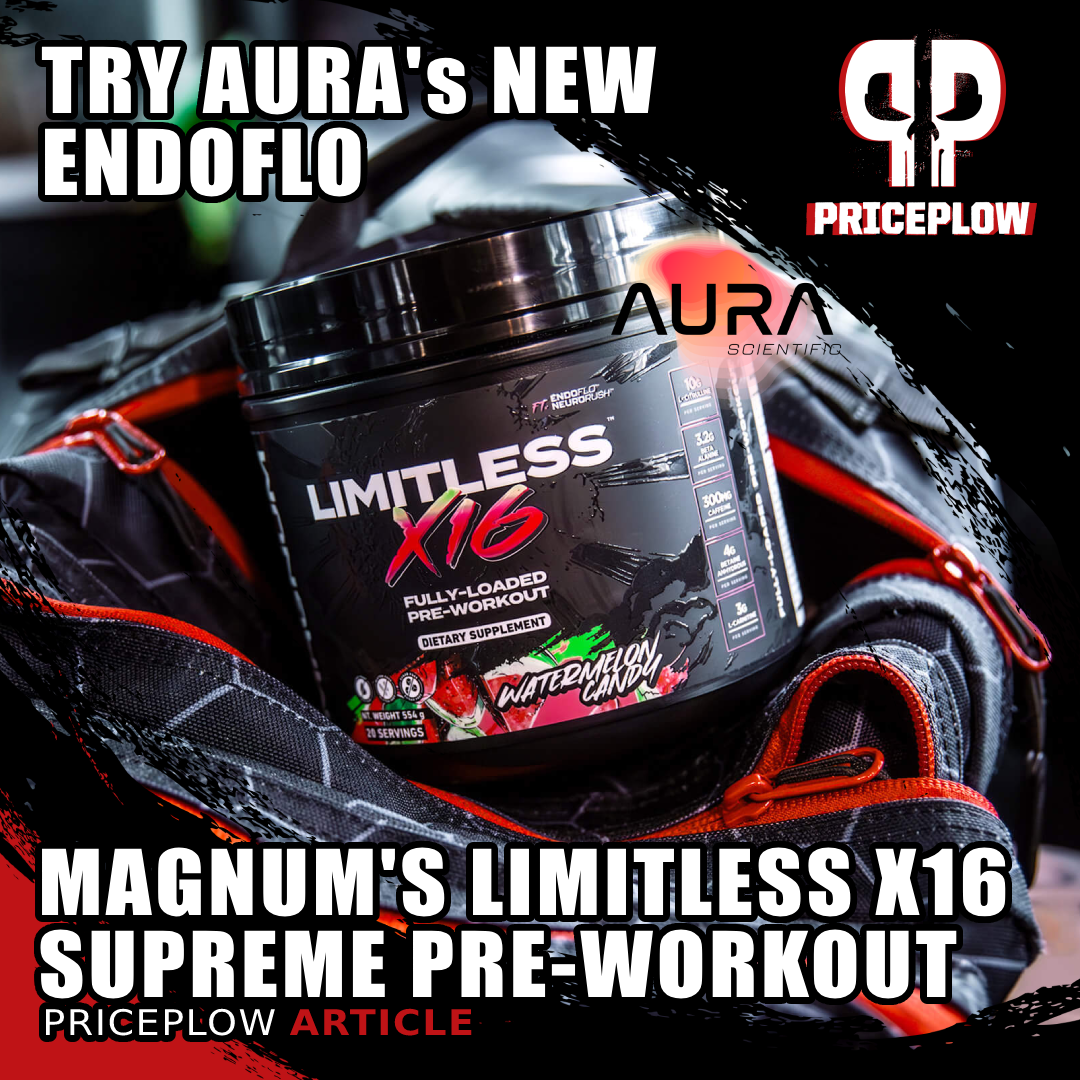
Magnum Nutraceuticals Limitless X16 pre-workout is on the next level with Aura Scientific's EndoFlo for mind-blowing pumps, NeuroRush for added energy and laser focus, and so much more.
In the nutritional supplement market, it's sad to admit, but the pre-workout supplement category has gotten a touch... stale. The quaffing of ergogenic powder -- usually (but not always!) mixed in water -- is the most venerable and effective bro science tradition, there's little variation between formulas. It seems like no matter how large a sample of pre-workouts you care to examine, you'll see the same handful of ingredients over and over again.
Pre-Workouts get a new boost in 2024 thanks to Aura Scientific
Fortunately for us, Aura Scientific has been working overtime to change all that. In the last year, Aura has come out with some insanely promising new designer ingredients – and now, two of them are finally getting their commercial debut in Limitless X16 from Magnum Nutraceuticals.
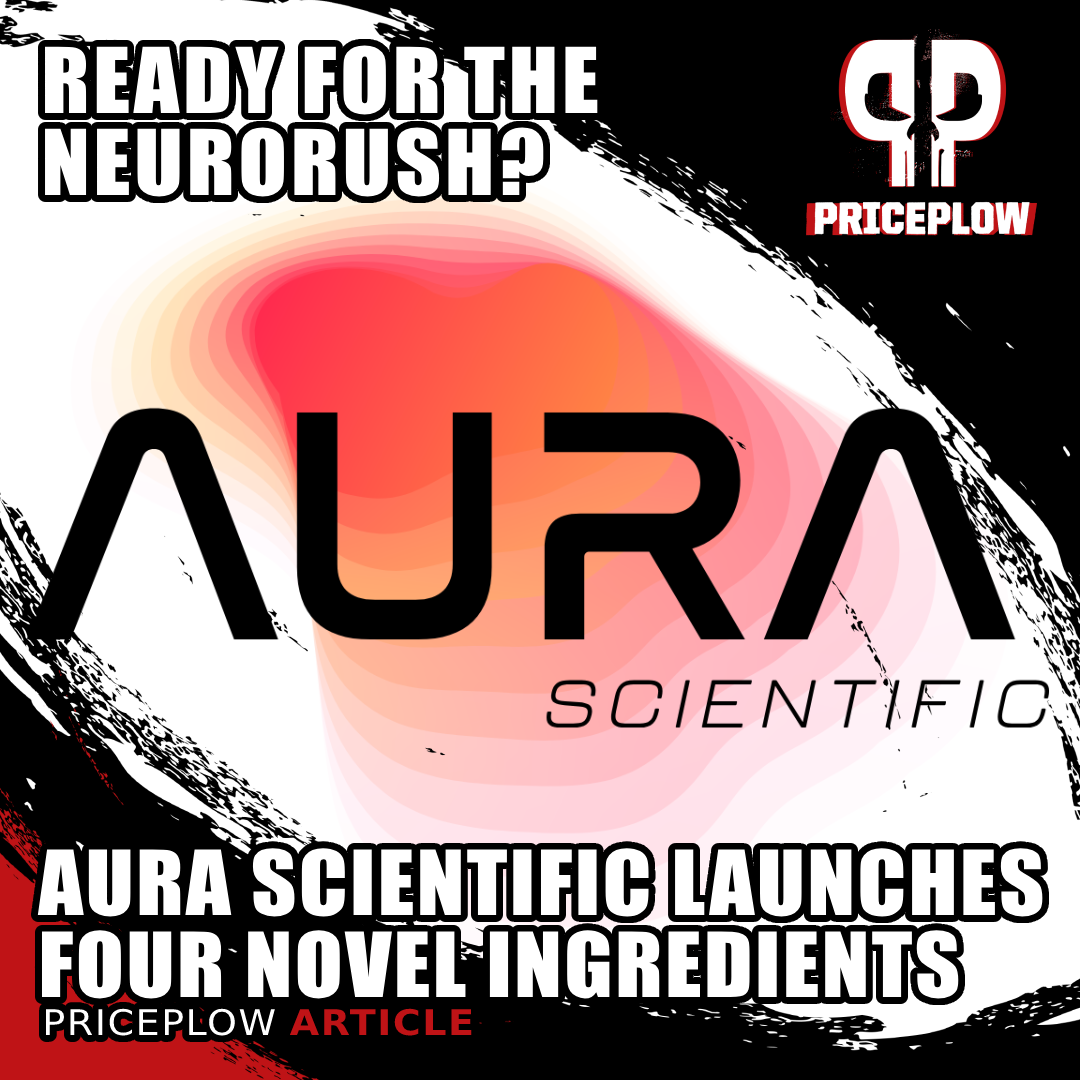
A new novel ingredient developer named Aura Scientific has launched, with four new ingredients that include a feel-good coffeefruit extract named NeuroRush. Get the first peak here today!
The Limitless formula, which definitely lives up to its name, features EndoFlo, Aura's vasodilatory support ingredient, and NeuroRush, which is a new-and-improved take on the coffee-derived polyphenol extracts we typically see in higher-end pre-workout formulas.
A serious upgrade to the previous nootropic pre-workout formula
It's been quite a while since we covered the original Magnum Limitless pre-workout, which was originally launched all the way back in 2015! It included a "Happy Brain Blend" that was heavy on nootropics, and still finds itself on sale as the last reserves get sold out. But it was time for a massive upgrade, and with the help of Aura, the Canadian masterminds at Magnum did not disappoint.
Let's get into how these awesome ingredients can help you achieve a massive pump, and take your lifts to the next level – but first, check PricePlow's availability and sign up for our Aura Scientific news:
Magnum Nutraceuticals Limitless X16 – Deals and Price Drop Alerts
Get Price Alerts
No spam, no scams.
Disclosure: PricePlow relies on pricing from stores with which we have a business relationship. We work hard to keep pricing current, but you may find a better offer.
Posts are sponsored in part by the retailers and/or brands listed on this page.
This area is reserved for Team PricePlow's upcoming videos.
Subscribe to our channel and sign up for notifications so you catch it when it goes live!
Magnum Nutraceuticals Limitless X16 Ingredients
In a single 1 scoop (27.3 gram) serving of Limitless X16 from Magnum Nutraceuticals, you get the following:
-
L-Citrulline – 10,000 mg
The conditionally essential amino acid citrulline can upregulate your body's production of nitric oxide (NO).[1] Recall that conditionally essential amino acids are aminos your body can produce in limited amounts, which may need to be supplemented under physically or mentally stressful conditions.
Your body converts citrulline to NO as follows: Citrulline → arginine → NO.
As you can see, there's an intermediary step between the citrulline and the end product, NO – arginine. So why not take arginine instead? After all, it's the most direct precursor.
It turns out that arginine's oral bioavailability is bad – so bad that orally-ingested citrulline ends up being better at raising blood arginine levels.[2-4] That extra serum arginine is what your body converts to NO.
We care about NO levels because the more NO you have in circulation, the more your arteries are able to expand in diameter, a process called vasodilation. During vasodilation, the same volume of blood moves through a bigger space, resulting in lower blood pressure and heart rate.[5-7]
Going from 10 to 15 grams of L-citrulline may have raised plasma citrulline levels dose-dependently, but the plasma arginine levels certainly didn't increase 50% alongside it! After 10, you hit the law of diminishing returns.[8]
Increased vasodilation means greater cardiovascular efficiency, resulting in higher tissue oxygenation, more efficient nutrient delivery, and improved disposal of cellular-metabolic waste. With vasodilation, you'll be able to push harder in the gym, and recover better when you sleep that night.
Athletic endurance, especially, benefits from NO-mediated vasodilation.
Studies on citrulline supplementation show that it can improve:
- Power and oxygen utilization[9]
- Athletic endurance – by roughly 50%[10]
- Post-exercise muscle soreness[10]
- Growth hormone (GH) production[11]
- Protein sparing[12]
- Muscle protein synthesis[13,14]
-
A massive 10 gram dose!
Magnum went big here -- this is no standard citrulline dose! Reason being, a study found that serum arginine increases linearly up to 10 grams, before it hit the law of diminishing returns somewhere between 10-15 grams.[8] Up to 10 grams, you basically get more serum arginine with more citrulline.
A 2018 study summarizing citrulline's impact on cardiovascular health also discusses this study:[15]
One such human study demonstrated a tolerance of up to 15 g l-citrulline per day in healthy volunteers.[8] By comparison, high-doses of l-arginine (~13 g) can induce significant gastrointestinal complications.[16,17] However, at 15 g doses of l-citrulline, a lower fractional absorption rate and plasma retention of l-citrulline was observed, potentially due to saturation of its transporters (e.g., ASC or B0,+-amino acid transporters) or reduced renal conversion of l-citrulline to l-arginine.
As such, the authors suggested a dose of 10 g l-citrulline for clinical use.[8] However, for increasing circulating l-arginine concentrations, doses of l-citrulline as low as 3 g have been shown to be effective.[4] Thus, the minimum effective dose is ~3 g/day, whereas the maximal effective dose may be as high as 10 g/day.[15]
Additionally, citrulline supplements can also upregulate ornithine,[18] an amino acid that can improve mental and physical endurance by helping detoxify ammonia.[19]
Ornithine supplementation can increase metabolic health and improve sleep satisfaction, while lowering subjective feelings of stress, by decreasing the body's ratio of cortisol to DHEA.[19]
-
Betaine Anhydrous – 4,000 mg
Another huge dose!
Betaine, also known as trimethylglycine (TMG), is a powerful ergogenic aid. This means that it can increase your body's capacity for physical work and, hence, athletic performance.
This compound is a potent methyl donor,[20] meaning it can help your cells synthesize adenosine triphosphate (ATP).[21] This is a big deal, because ATP is your body's energy currency, the fuel that your cells use to perform all their metabolic functions, including exercise. Relative to other nutritional supplements, betaine is one of the most powerful methyl donors known to science.[22]
Betaine can also upregulate key metabolic regulators like AMP-activated protein kinase (AMPK), which is one of your body's "need energy now" messengers. Increasing AMPK expression causes a cascade that usually results in a faster cellular-metabolic rate.[23]
Lastly, betaine is an osmolyte, meaning it changes the behavior of cellular fluids. More specifically, betaine has been shown to affect extracellular osmotic pressure, resulting in the movement of extra water into your body's cells. This causes cellular hyperhydration, a generally desirable state that increases your cells' resistance to heat and their access to important nutrients.[20,24-30]
Muscle growth research
A landmark 2013 study showed that 2.5 grams of betaine every day can have profound effects on body mass and strength[29]
There was one really impressive study, from 2013, which found that a 2.5 gram daily dose of betaine – far less than what we have in Limitless X16 – caused an average 5.3 pound gain in lean muscle and 6.4 pound fat loss.[29,31]
A followup study by the same team of scientists showed that the 2.5 gram dose, when given to female collegiate weightlifters, resulted in significantly greater fat loss during resistance training, compared to placebo.[32]
And not only do we have more than 2.5 grams here, we have 60% more over those clinically-studied doses! This supplement is clearly not messing around.
-
Beta Alanine – 3,200 mg
Beta-alanine is another potent ergogenic aid. When it combines with the amino acid histidine, it forms carnosine, a dipeptide molecule that helps detoxify lactic acid in your muscle tissue. This can ultimately improve performance by discouraging excess lactic acid accumulation, which can be a major factor in fatigue.[33]
Carnosine itself isn't very bioavailable when taken orally, making beta-alanine supplementation a better strategy for increasing serum carnosine levels. And since large amounts of histidine are present in commonly-eaten foods, beta-alanine availability is almost always your body's limiting factor in carnosine synthesis.[34,35]
Two meta-analyses, looking at over 40 peer-reviewed papers, found that beta-alanine is best at improving during exercises that can be sustained for 30 seconds to 10 minutes at a time.[36,37]
Don't sweat the tingles!
If you feel a tingling sensation in your face or torso after ingesting beta-alanine, don't worry – it's benign.[38]
-
L-Carnitine L-Tartrate – 2,000 mg
L-carnitine L-tartrate is a special form of carnitine used by supplement manufacturers who prize its high bioavailability and rapid action.[39]
A study carried out in resistance-trained men found that 2 grams of L-carnitine L-tartrate (LCLT), taken once daily, can significantly increase cellular oxygen delivery, which can ultimately increase cellular-metabolic rate.[40]
Perhaps more importantly, the same study found that LCLT can increase androgen receptor density, thus potentiating the action of circulating testosterone.[40] Since the binding of testosterone to the AR is what actually causes T's androgenic effects, increasing AR density is functionally equivalent to increasing testosterone levels.
Interestingly, increased AR density caused a drop in serum testosterone, as more testosterone was taken up by cells and put to use intracellularly.[40]
In a word, LCLT is the form of carnitine tested on androgenic potential. This is a workout-friendly ingredient that we don't see in pre-workouts often enough -- and we're not done with carnitine yet!
-
Tyrosine – 1,500 mg
The amino acid tyrosine is a great anti-stress supplement, with a side of nootropic benefits. It's an important precursor to the catecholamine neurotransmitters like dopamine, adrenaline, and noradrenaline,[41-45] which play a crucial role in helping you feel focused, motivated, and energetic.
Tyrosine can also increase your thyroid's production of triiodothyronine (T3) and thyroxine (T4),[46,47] your body's thyroid hormones. This can be a huge support for body recomposition, since the two behaviors typically required for an efficient recomp – caloric restriction and exercising – both hammer thyroid function.[46,47]
Like carnitine, we're also not done with tyrosine yet -- there's a bit more coming in an alternate form as well.
-
Acetyl L-Carnitine – 1,000 mg
Acetyl L-carnitine (ALCAR) is the nootropic form of carnitine. Supplementation with this acetylated quaternary ammonium compound confers neuroprotective, neurotrophic, and even antidepressant benefits.[44]
After reading a new review based upon 100 citations,[48] we are finding fewer and fewer reasons not to take ~2g L-Carnitine each day.
ALCAR's particularly acute effect on the central nervous system can be attributed to the fact that it readily crosses the blood-brain barrier (BBB),[49] which most nutritional supplements are not capable of doing. Animal research has demonstrated that ALCAR administration can increase synaptic plasticity in mammalian brain tissue, and improve learning.
One particularly compelling human study, carried out in mild cognitive impairment (MCI) patients over the age of 65, found that those who took ALCAR performed significantly better on a cognitive battery than than placebo group.[50]
All told, we have a total of 3 grams of total carnitine-containing ingredients here - massive!
-
N-Acetyl Tyrosine – 500 mg
N-acetyl tyrosine (NALT), is just the amino acid tyrosine, with an attached acetyl group. It comes with all the benefits we discussed in the tyrosine section above. However, contrary to prevailing industry belief, NALT is in no way superior to free tyrosine (i.e., L-tyrosine) – if you're interested in learning more about this, read our comprehensive discussion of the issue in our previous post L-Tyrosine vs. N-Acetyl L-Tyrosine: A Tale of Two Tyrosines.
Ultimately, though, this is still a little extra tyrosine, which can't hurt and definitely could help. This brings us to 2 grams of total tyrosine, something we definitely get excited about.
-
Alpha-GPC (50% L-Alpha-Glycerylphosphorylcholine) – 300 mg
The original advertising from the 2015 version of Limitless still rings true -- there's way more pump action in this than the competition.
Alpha-GPC is a kind of choline, an essential B vitamin that your body uses to synthesize and repair the phospholipid bilayer membranes that encapsulate the contents of all your body's cells.[51] Additionally, choline plays an essential role in some of the intercellular signaling functions performed by these membranes.[51]
Choline is also one of the building blocks for acetylcholine, a neurotransmitter that coordinates some of the brain's most important learning processes.[52] Increased acetylcholine synthesis via supplemental choline ingestion can significantly improve cognitive performance, particularly when it comes to memory consolidation, the conversion of short-term memories into long-term ones.[53,54]
Compared to other forms of choline, alpha-GPC has a superior ability to cross the blood-brain barrier, making it the nootropic form of choline.[55]
-
N-Acetyl Cysteine – 300 mg
N-acetyl cysteine (NAC) is a direct precursor to glutathione (GSH), your body's most potent endogenous antioxidant.[51]
Generally speaking, increased antioxidant activity is a good thing, so it's natural to wonder whether GSH supplementation is possible. As it turns out, oral GSH's bioavailability is too low to be effective.[52] Once again, we see that the precursor, which is NAC in this case, has much better bioavailability, making it a more effective target for supplementation.
Technically speaking, cysteine is the precursor, but taking an acetylated form like NAC increases bioavailability by sparing the cysteine from the first pass effect.[53,54]
A 2017 research review of NAC supplementation found that NAC can improve:[55]
- Female hormonal and reproductive health
- Birth outcomes
- Liver resilience
- Fertility
- Bronchitis symptoms
- Muscular performance
- Hemodialysis
- Asthma symptoms
- Neurodegenerative illness symptom severity
In particular, NAC is great for liver health and function,[57] which is important since the liver is so crucial for overall health and wellness.
This is another ingredient we don't generally see in pre-workouts, but it's one that can definitely support health related to fitness.
-
EndoFlo (Mango [Mangifera indica] Fruit Extract, Black Ginger [Kaempferia parviflora] Root Extract, Ginkgo [Ginkgo biloba] Leaf Extract, Pine [Pinus massoniana] Bark Extract) – 250 mg
EndoFlo is a compelling new ingredient from Aura Scientific. It's a proprietary blend of four botanical extracts shown to have powerful effects on vasodilation and hence, circulation. Here's what's under the hood:
-
Mangifera indica (mango fruit)
Mango fruit extract is one of the supplement industry's biggest growth ingredients – right now there are quite a few nutraceutical houses exploring potential applications for Mangifera indica's powerful bioactive constituents.
Among other things, Mangifera has significant phosphodiesterase 5 (PDE5) inhibiting activity,[54] which results in increased levels of cyclic guanosine monophosphate (cGMP). Elevated cGMP causes smooth muscle relaxation and vasodilation, enhancing blood flow to specific areas, including the penis (Viagra is also a PDE5 inhibitor).
However, it would be a mistake to regard the effects of PDE5 inhibitors as merely local – the systemic improvements in circulation are behind the growing use of drugs like sildenafil (Viagra) and tadalafil (Cialis) for sports performance enhancement[58] and anti-aging applications in functional medicine.[59]
In skin care, mango extracts are often used to improve circulation in skin tissue.[60,61] It even has great CNS effects![62]
-
Kaempferia parviflora (black ginger)
Black ginger is perhaps the most versatile bioactive constituent in EndoFlo – emerging research suggests that this botanical has potential uses in a huge range of applications, from dampening inflammation to fighting obesity, extending muscular endurance, and increasing strength.
One human study showed that black ginger supplementation increased grip strength, leg strength, sprint speeds, and hip and upper body flexibility.[64]
Other studies have found that black ginger can:
- Trigger vasodilation[65-68]
- Increase muscular endurance (via AMPK upregulation)[69,70]
But what's perhaps most compelling is the animal data showing that a particular flavonoid in black ginger, namely 5,7-dimethoxyflavone (DMF), is a potent vasodilatory, cardioprotective PDE5 inhibitor.[71-73]
Other animal research has shown that DMF can increase muscle growth and strength.[63,74]
-
Ginkgo biloba extract
You've probably heard ginkgo biloba mentioned as a powerful nootropic supplement – as it turns out, those brain benefits are largely due to ginkgo's ability to increase cerebral blood flow.[75,76]
Ginkgo contains lots of terpene lactones, which are cardioprotective thanks to their documented antiaggregant effects.[77]
Like other EndoFlo ingredients, Ginkgo has also been shown to inhibit PDE5, as well as PDE4.[78]
-
Pinus massoniana (pine bark)
Pine bark extracts have a long history of use as vasodilatory and cardioprotective supplements – we see various pine species show up in pump-focused pre-workouts all the time, thanks to their high concentration of proanthocyanidins, which have powerful anti-vasoconstrictive effects.[79] It also contains key antioxidants, like catechin and epicatechin, that have a huge volume of data showing their cardiovascular benefit (just google "Camellia sinensis cardiovascular benefits" and you'll get thousands of results on catechins).[79,80]
Overall, this is an incredibly exciting pre-workout support ingredient. Paired with the behemoth dose of L-citrulline, we're very confident you'll be getting some massive pumps.
You can read more about it in our article, "EndoFlo: Enhancing Vascular Health, Pumps, and Workout Performance".
-
-
Caffeine Anhydrous – 200 mg (of 301mg total)
Famed methylxanthine stimulant caffeine has an incredible ability to cross the blood-brain barrier, enabling it to profoundly affect the function of the brain and central nervous system. This is why, depending on your individual genetics, caffeine can be such a beneficial mood booster, focus enhancer, and even ergogenic aid.[81]
Caffeine's ability to reduce fatigue can be explained largely by its antagonism of adenosine, a nucleotide byproduct of ATP hydrolysis that accumulates in brain tissue while you're awake, thereby causing fatigue.[82,83] By blocking the adenosine receptor, caffeine can prevent adenosine from exerting its pro-fatigue effect, thus helping you stay alert and awake longer than you ordinarily might.
Are you a slow, medium, or fast caffeine metabolizer? In this study, ~46% of all participants were fast caffeine metabolizers (A/A),[84] meaning more than half of individuals aren't optimal caffeine consumers!
In sports nutrition contexts, caffeine is used as a mild performance-enhancing agent. This is possible thanks to caffeine's ability to increase cellular-metabolic rate through the inhibition of phosphodiesterases 1 through 4, which increases the expression of a secondary messenger molecule named cyclic adenosine monophosphate (cAMP). Because cAMP tells your cells to produce energy, upregulating cAMP via PDE inhibition has a slight metabolism boosting effect.[82,85,86]
Caffeine is also a potent fat burner,[87,88] an effect that shows up at doses as small as 3 mg/kg body weight.[89]
Thanks to its cellular-metabolic impact, caffeine can improve various dimensions of athletic performance, including strength, speed, and endurance.[83,87,88,90]
Caffeine also has significant nootropic effects on dimensions of cognition like attention, vigilance, reaction times, and working memory.[91-93]
Note – the total amount of caffeine in Limitless X16 is 301 mg, which is a significant dose. If you aren't sure whether you should take this much supplemental caffeine, please ask your doctor for medical advice.
-
NeuroRush (Coffee Fruit Extract) (2% Caffeine) – 150 mg
NeuroRush is a new designer coffee fruit extract from Aura Scientific, standardized to contain a whopping 50% chlorogenic acid by weight. It also contains significant amounts of a compelling bioactive constituent called 5-caffeoylquinic acid.
Internal PricePlow testing has shown us that NeuroRush is a powerful feel-good ingredient, adding some mild euphoria on top of any stimulant it's stacked with.
But besides just feeling good, coffee fruit extracts like NeuroRush have been shown to confer significant cognitive benefits.
Increased vigilance
One 2019 study showed that only 100 mg of coffee fruit extract can significantly attenuate the decline in vigilance, and corresponding increase in mental fatigue, that people usually experience after performing a sequence of demanding mental tasks.[94] One interesting thing to note about this study was that the effect wasn't dose-dependent – 100 mg of coffee fruit extract had the same mental energizing effect as 300 mg.
A new novel ingredient developer named Aura Scientific has launched, with four new ingredients that include a feel-good coffeefruit extract named NeuroRush. Get the first peak here today!
The chlorogenic acid factor
The main bioactive constituent of NeuroRush, chlorogenic acid, has a rich body of research literature backing its ability to improve cognitive performance and mood, largely through its antioxidant and anti-inflammatory effects.[95-97]
Pro-longevity effects
Coffee fruit extracts could have a pro-longevity effect – there's tons of research showing that coffee consumption is linked to increased lifespan and healthspan,[98-101] and animal studies suggest that coffee extracts may confer similar benefits.[102]
Awesome safety profile
One of the best things about coffee fruit extracts is that they're as safe as it gets, and there's a mountain of first-rate studies showing this.[103]
Chlorogenic acid alone has tons of safety studies behind it, including a massive research review titled "The Biological Activity Mechanism of Chlorogenic Acid and Its Applications in Food Industry: A Review"," which describes chlorogenic acid's antioxidant power in great detail.[104]
You can learn more in our main NeuroRush article. This is an ingredient to watch – Aura Scientific is doing great work in general, but they're really taking coffee fruit extracts to the next level. Read more in our article titled "Aura Scientific: Novel Ingredient Developer Introduces 4 New Ingredients" for more info.
This provides 3 milligrams of caffeine - very little, but it does push us over the 300mg threshold after we add in the next ingredient:
-
Green Coffee Bean Extract (98% Caffeine) – 100 mg (yields 98 of 301mg caffeine)
The standardization of this green coffee bean extract makes it an excellent source of natural caffeine, which comes with all the benefits we described in the caffeine anhydrous section above.
Generally speaking, we prefer natural caffeine to synthetic stuff – it's a lot less likely to be contaminated with residues of solvents, and other industrial chemicals, that can be involved in synthetic caffeine production.
Note – this brings the total amount of caffeine in Limitless X16 up to 301 mg, which is a significant dose. If you're unsure of your tolerance, start at half of a scoop.
-
Theacrine (from 125 mg TeaCrine 40%) – 50 mg
Theacrine is a stimulant alkaloid, closely related to caffeine,[105] which is typically derived from a particular Chinese variety of tea called Camellia kucha, sometimes referred to simply as kucha tea.[106]
Theacrine is similar to caffeine, but definitely not the same, providing a possibly far longer lasting effect.
Theacrine's mechanisms of action will sound familiar by now – it has anti-fatigue effects thanks to its adenosine antagonism,[107] and also upregulates cAMP via phosphodiesterase inhibition.[108]
Theacrine is also dopaminergic,[109] meaning it can help improve focus, motivation, and energy.
When it comes to athletic performance, theacrine administration has been shown to increase time to exhaustion at 85% VO2max by 27-38%,[110] which is a huge effect size.
-
Huperzia Flower Extract (1% Huperzine) – 20 mg
Huperzia serrata extracts are typically standardized for huperzine A, a sesquiterpene alkaloid that inhibits acetylcholinesterase, the enzyme responsible for breaking down acetylcholine.[111] This makes Huperzia a great ingredient for synergy with acetylcholine boosters like alpha-GPC – while the choline increases acetylcholine levels, Huperzia helps that surplus acetylcholine last even longer than usual.
Huperzine A has also been shown to promote neurogenesis, the birth of new neurons.[112]
-
Naringin (from Grapefruit [Citrus Paradisi] Extract) – 10 mg
Grapefruit extracts contain two unique compounds (6,7-dihydroxybergamottin and Naringin) that help to boost metabolism and accelerate fat loss!
The flavonoid naringin helps us enjoy the benefits of NO upregulation, while limiting the downsides – it scavenges NO free radicals[111] and selectively downregulates iNOS, the NO-producing enzyme involved in the inflammatory stress response.[112]
Naringin has also been shown to decrease the expression of metalloproteinases-9 (MMP-9), a key antioxidant and anti-inflammatory mechanism. A limited body of evidence suggests that decreasing MMP-9 expression can help increase athletic endurance.[113]
Naringin may also ease breathing during intense exercise, by reducing inflammation and exerting bronchodilatory effects.[114]
Flavors Available
Conclusion: A Limitless Pre-Workout
What a fantastic upgrade to the original LIMITLESS, which we loved when it hit the scene. But as time moves on, ingredient technology does too, and we're thrilled to see Magnum Nutraceuticals keeping pace.
Magnum's Limitless X16 is based on a core of tried-and-tested ingredients like citrulline, beta-alanine, betaine, and caffeine, but really takes things to the next level with EndoFlo and NeuroRush. We are very excited to see these ingredients, especially when paired next to such a monstrous formula.
This product is an auspicious beginning for these two heavy-hitters from Aura Scientific, and we can't wait to see how the industry continues putting them to use.
Magnum Nutraceuticals Limitless X16 – Deals and Price Drop Alerts
Get Price Alerts
No spam, no scams.
Disclosure: PricePlow relies on pricing from stores with which we have a business relationship. We work hard to keep pricing current, but you may find a better offer.
Posts are sponsored in part by the retailers and/or brands listed on this page.
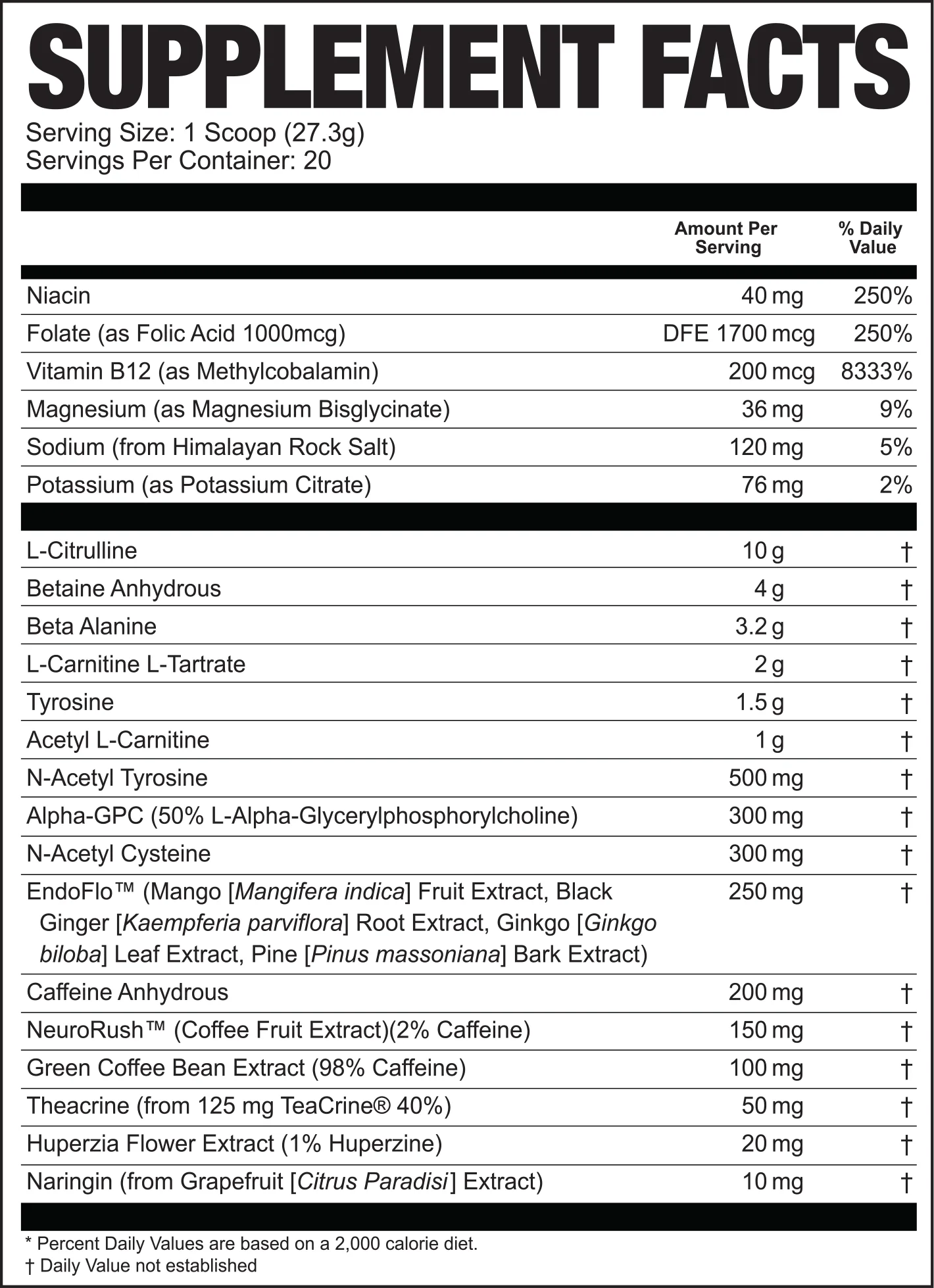
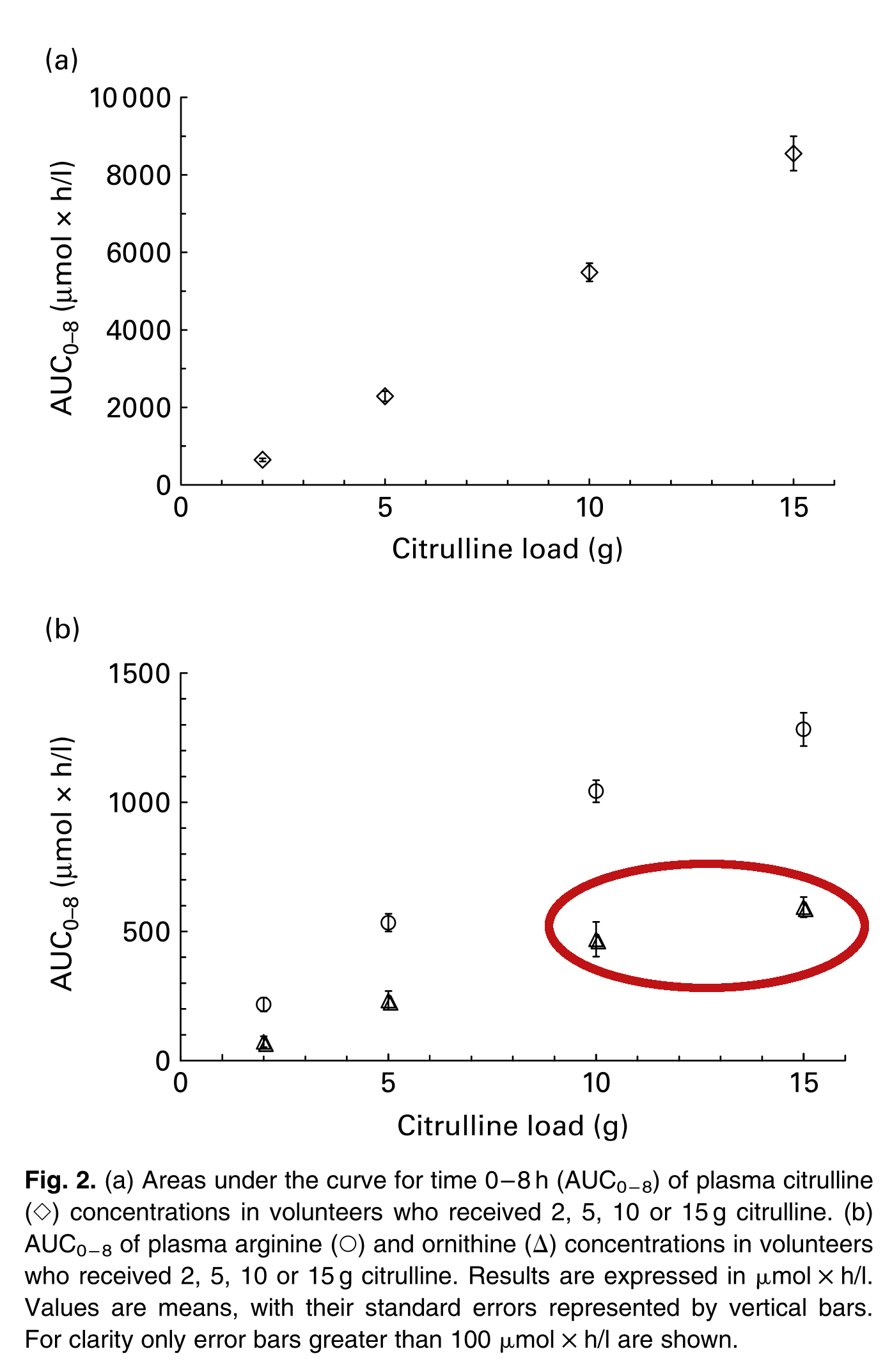
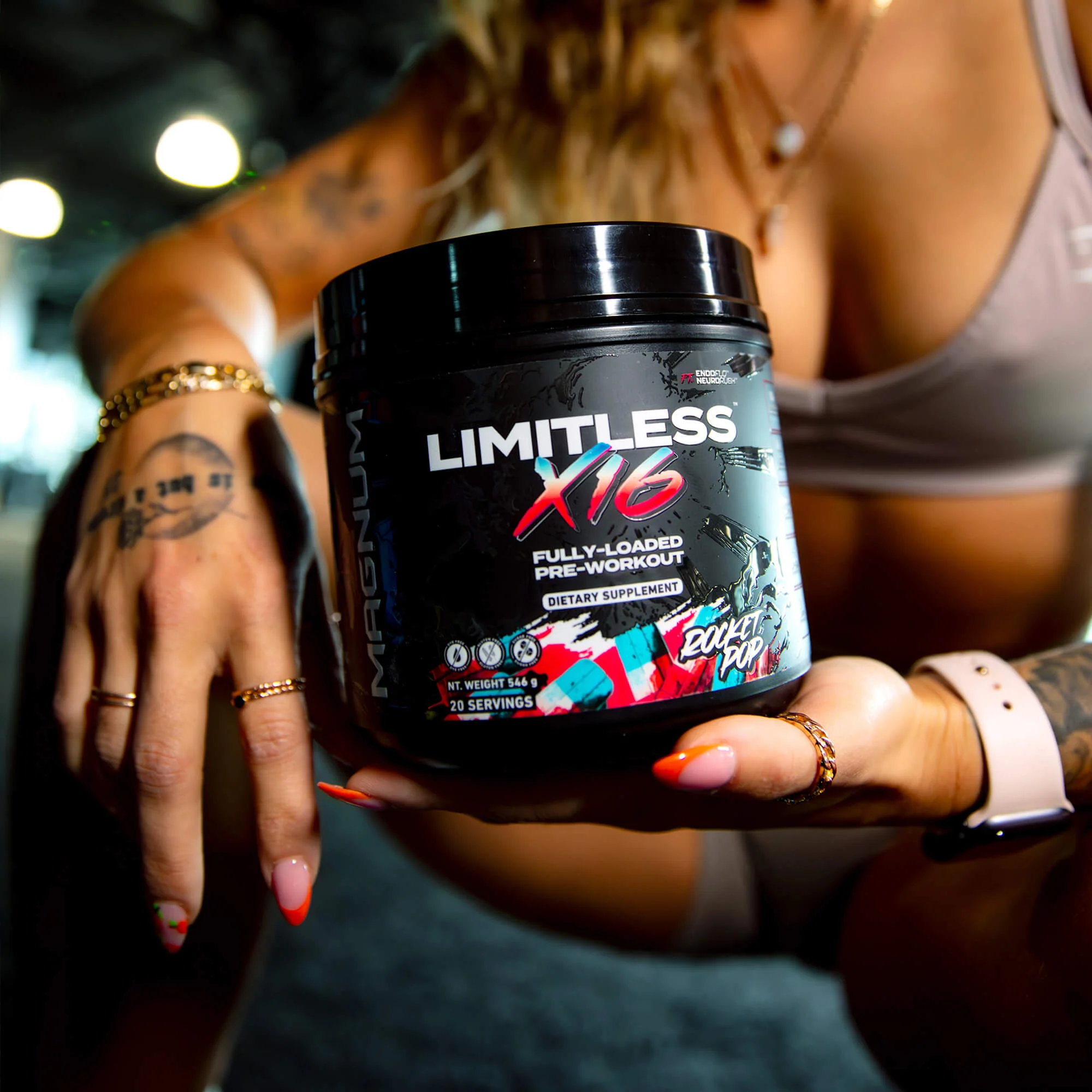

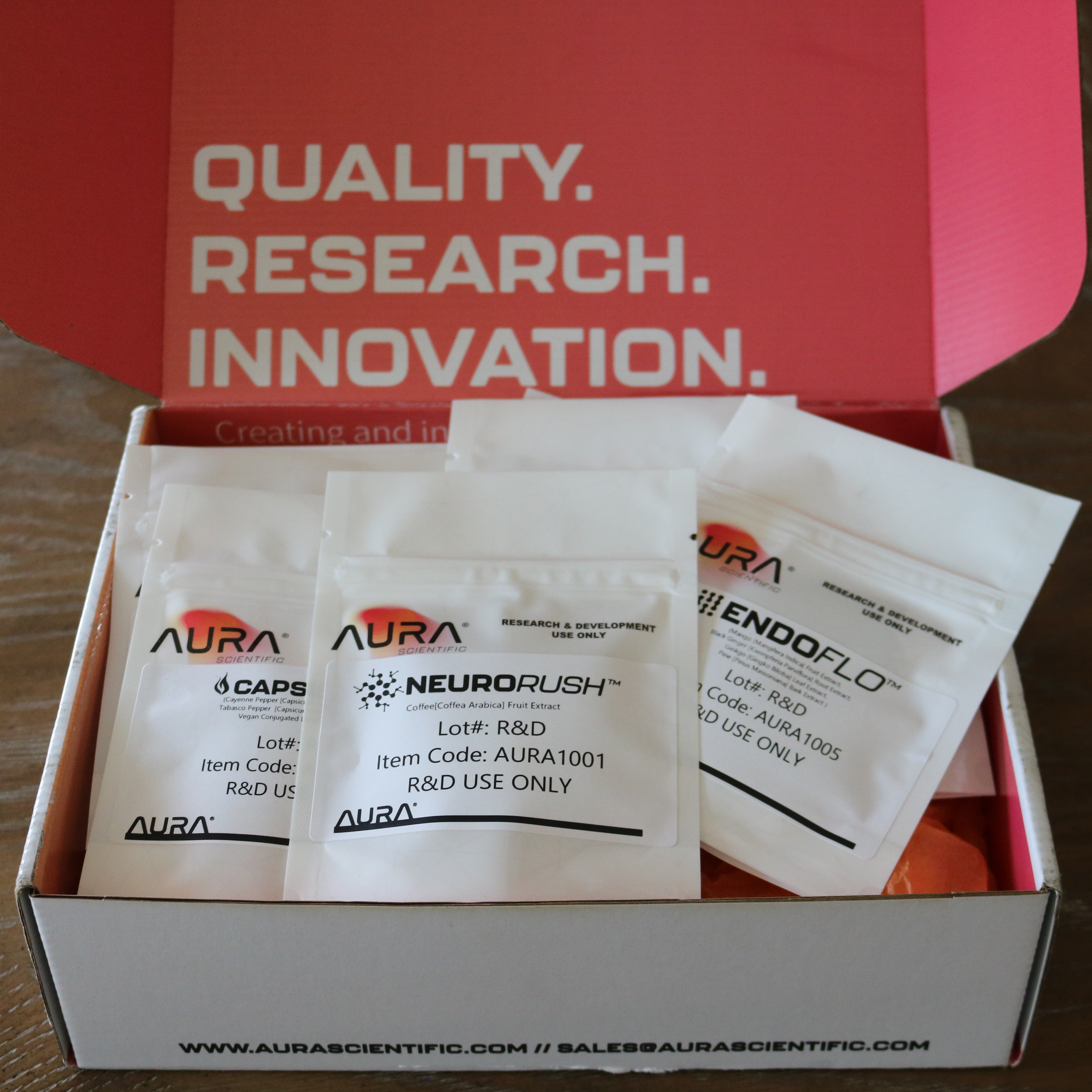
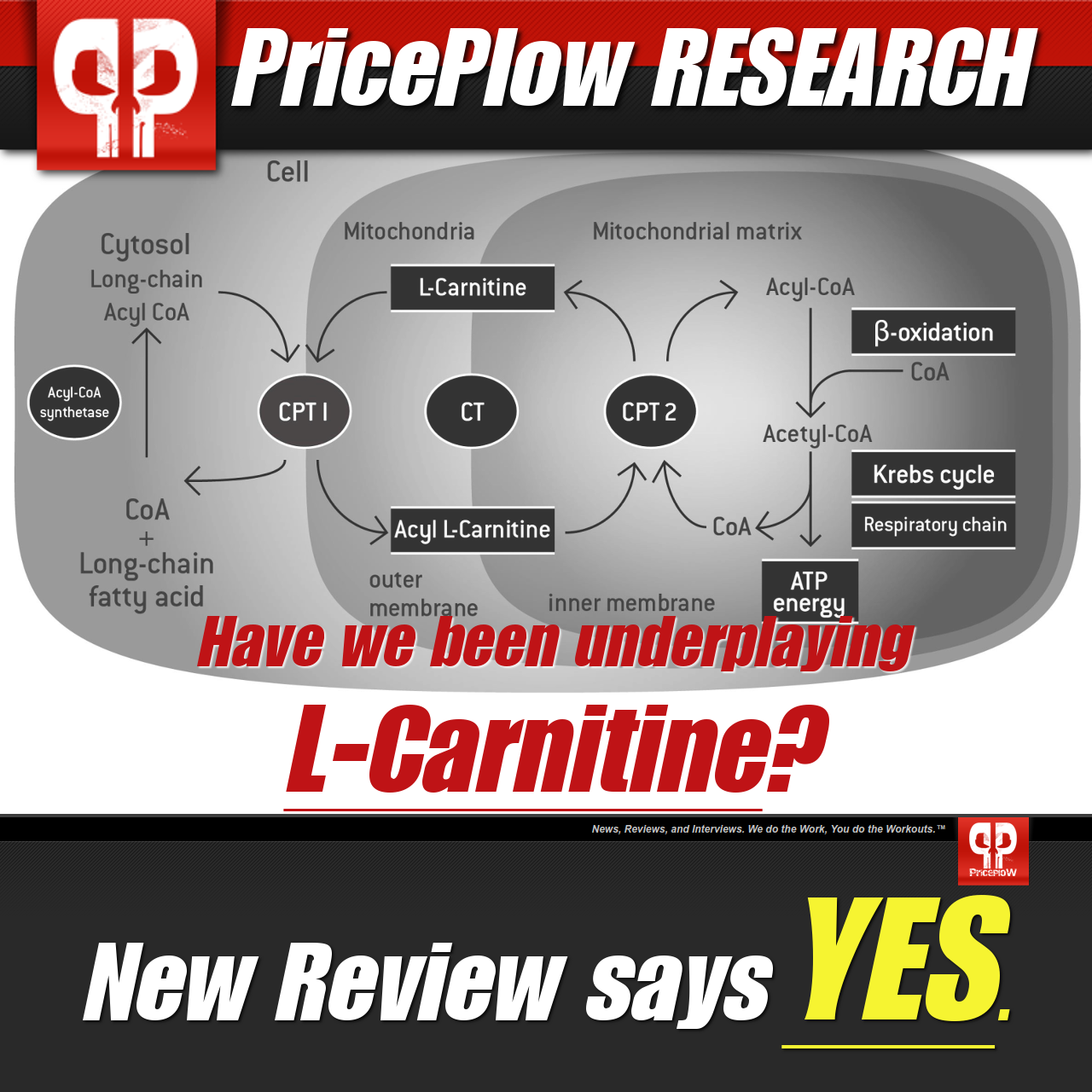
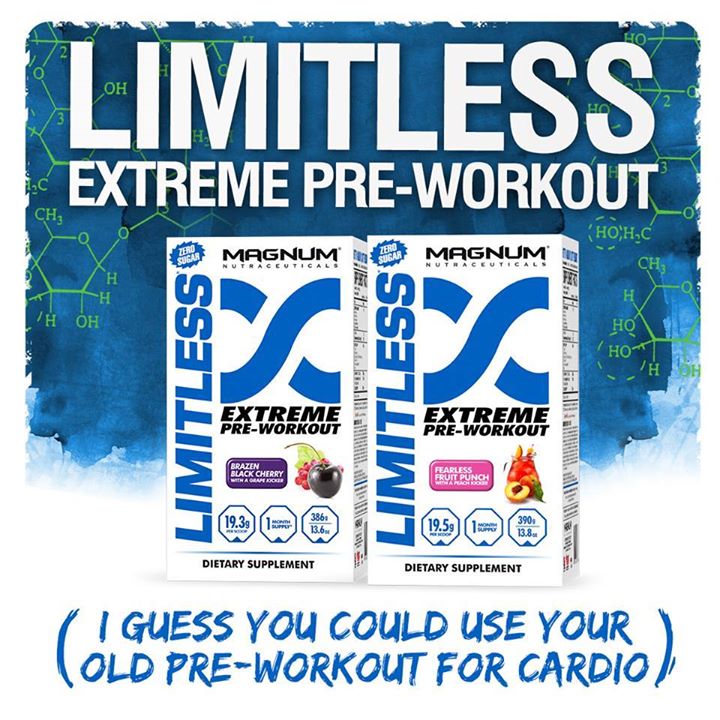
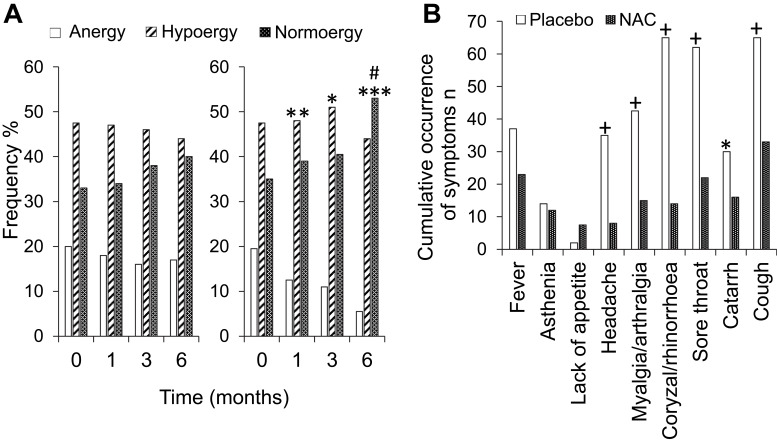
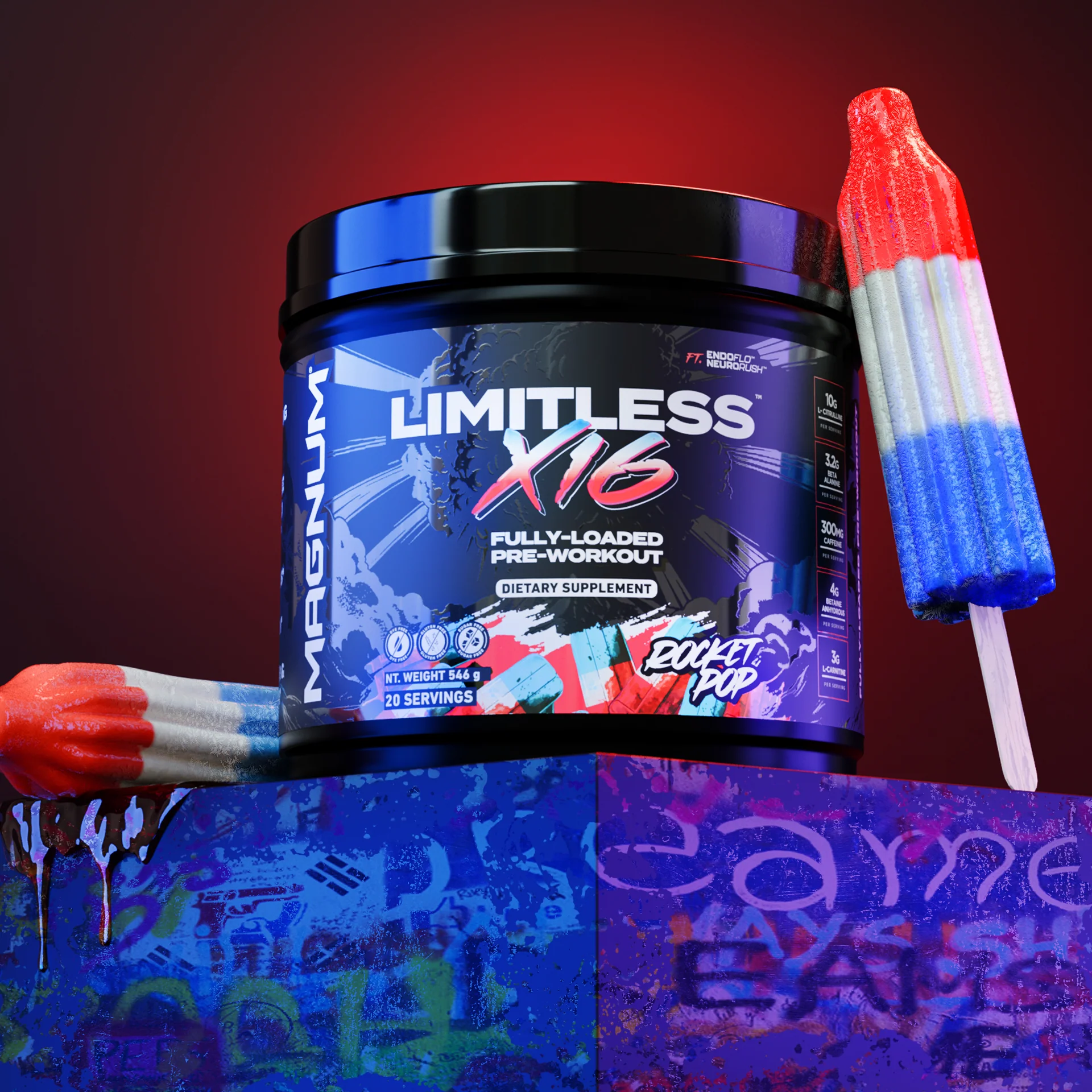
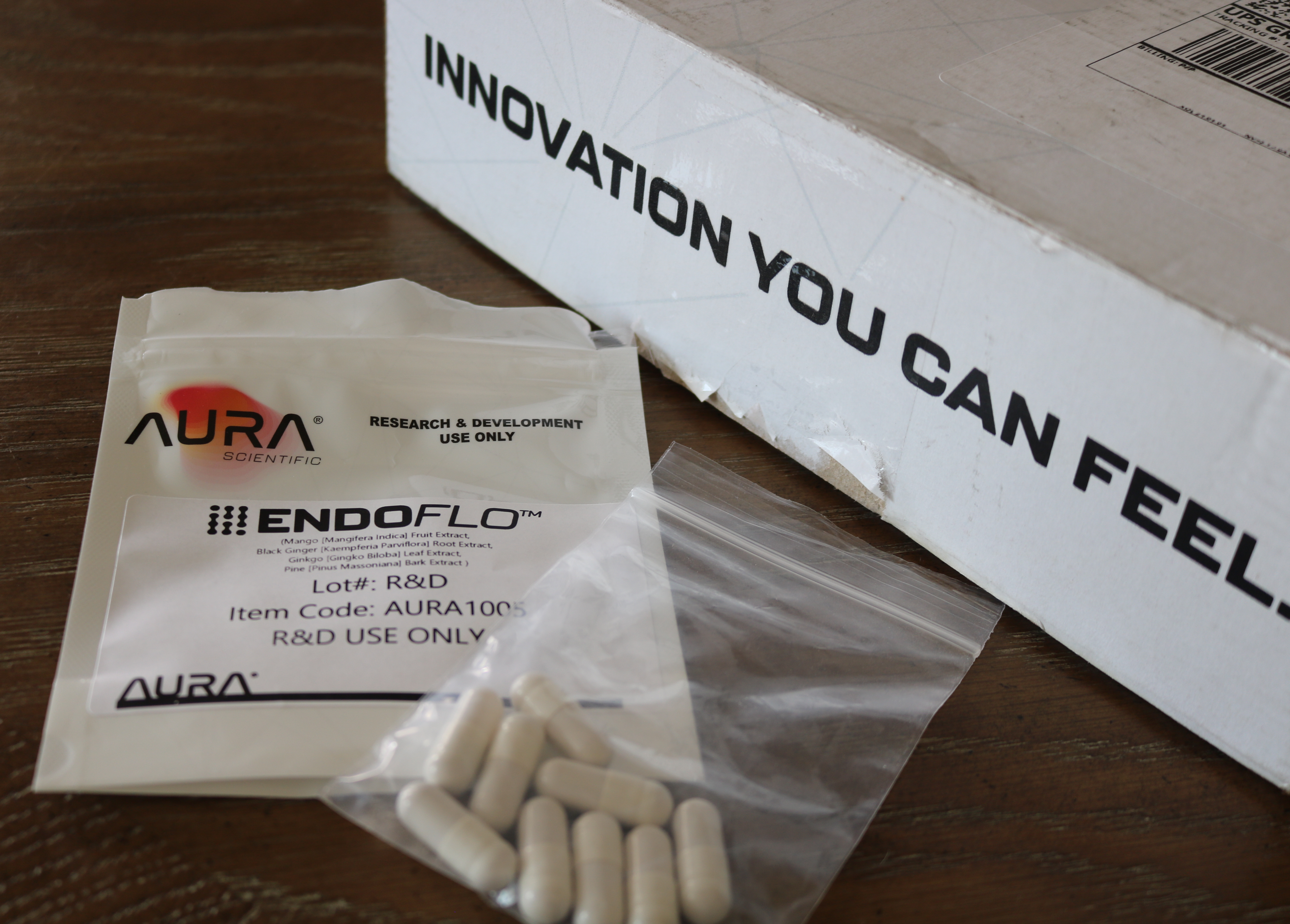
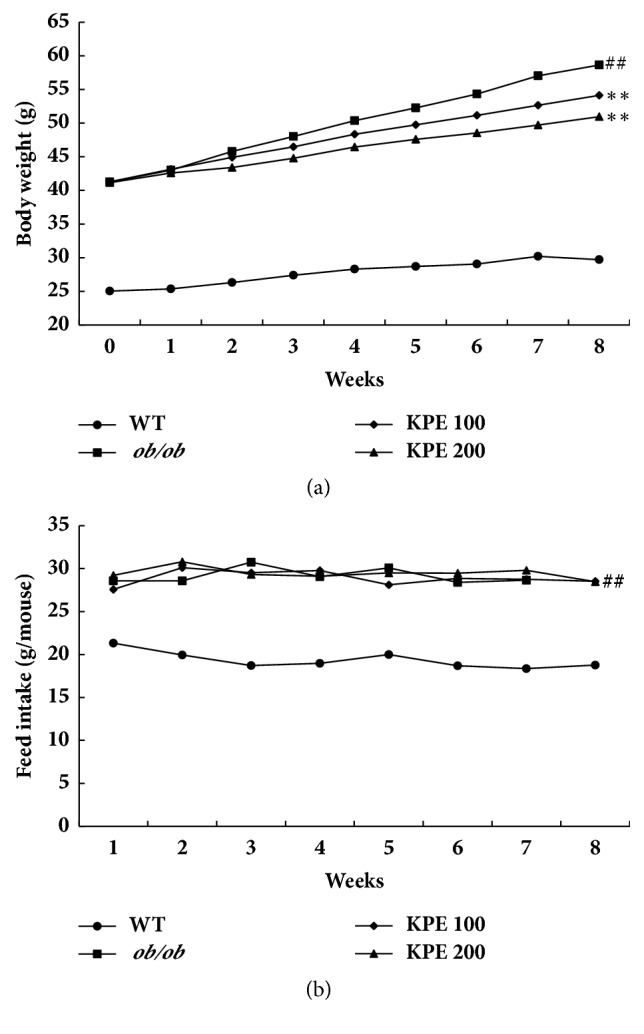
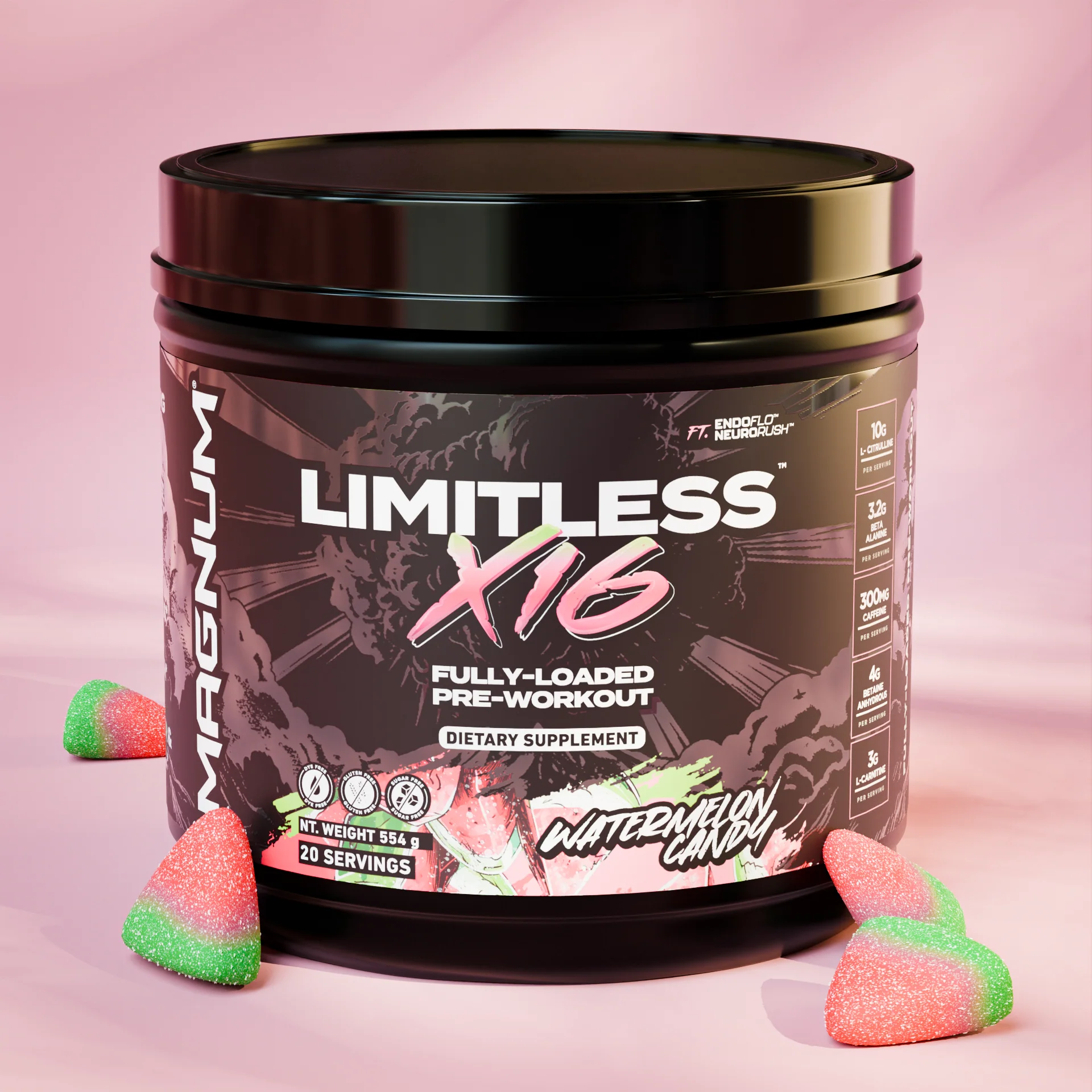
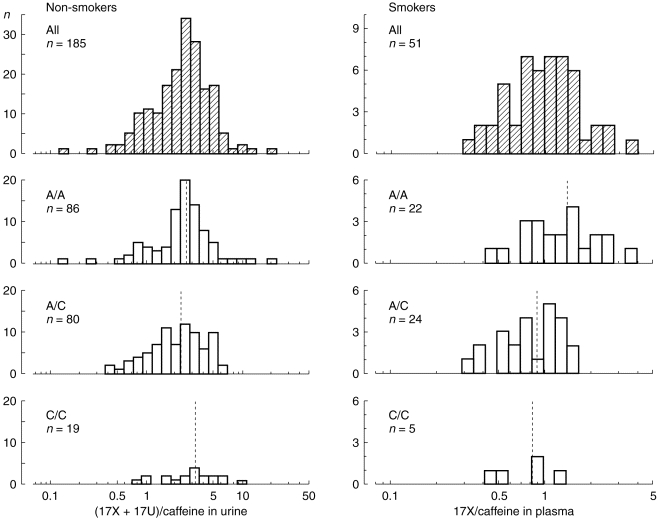

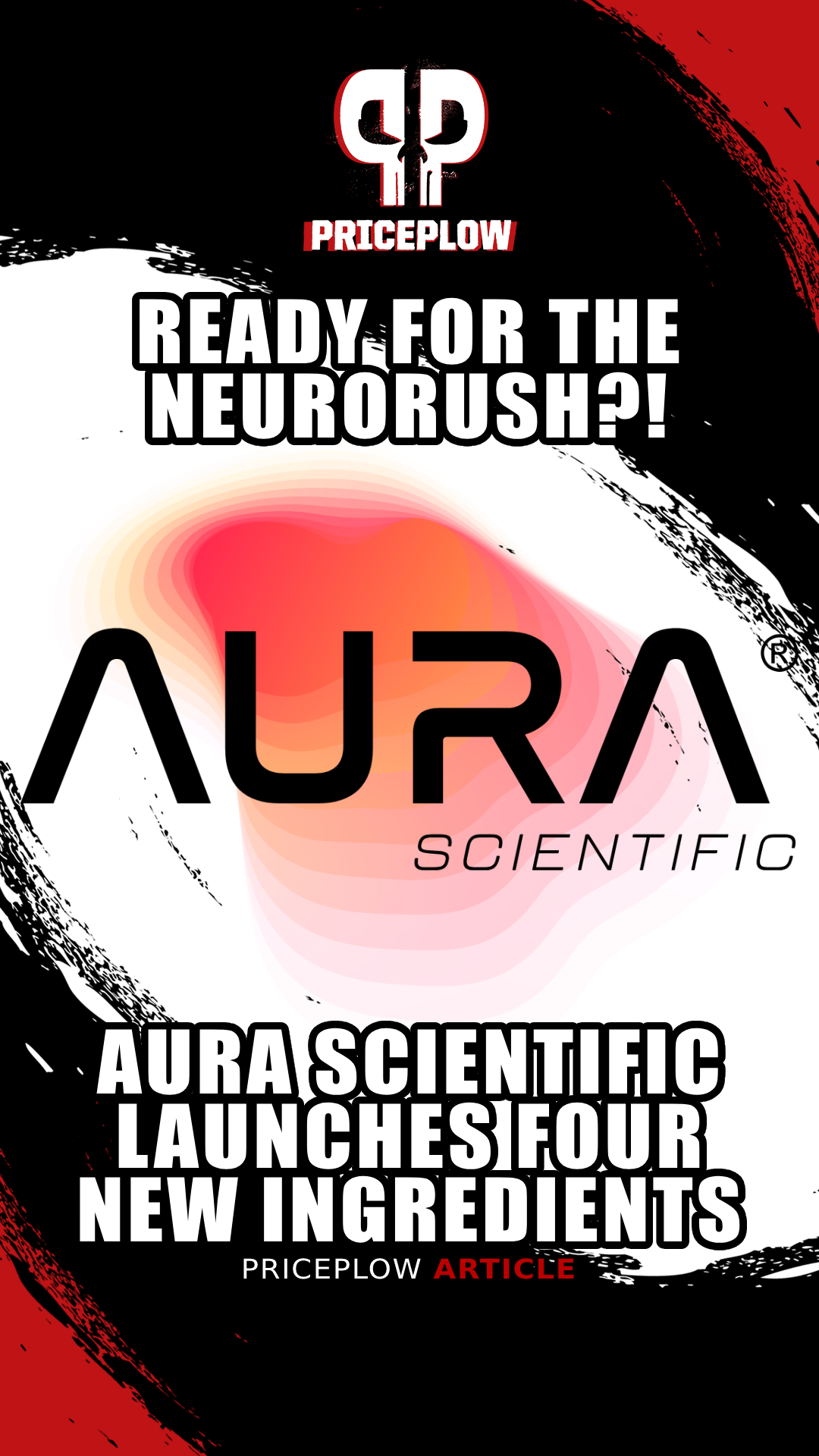
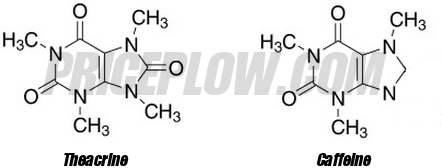
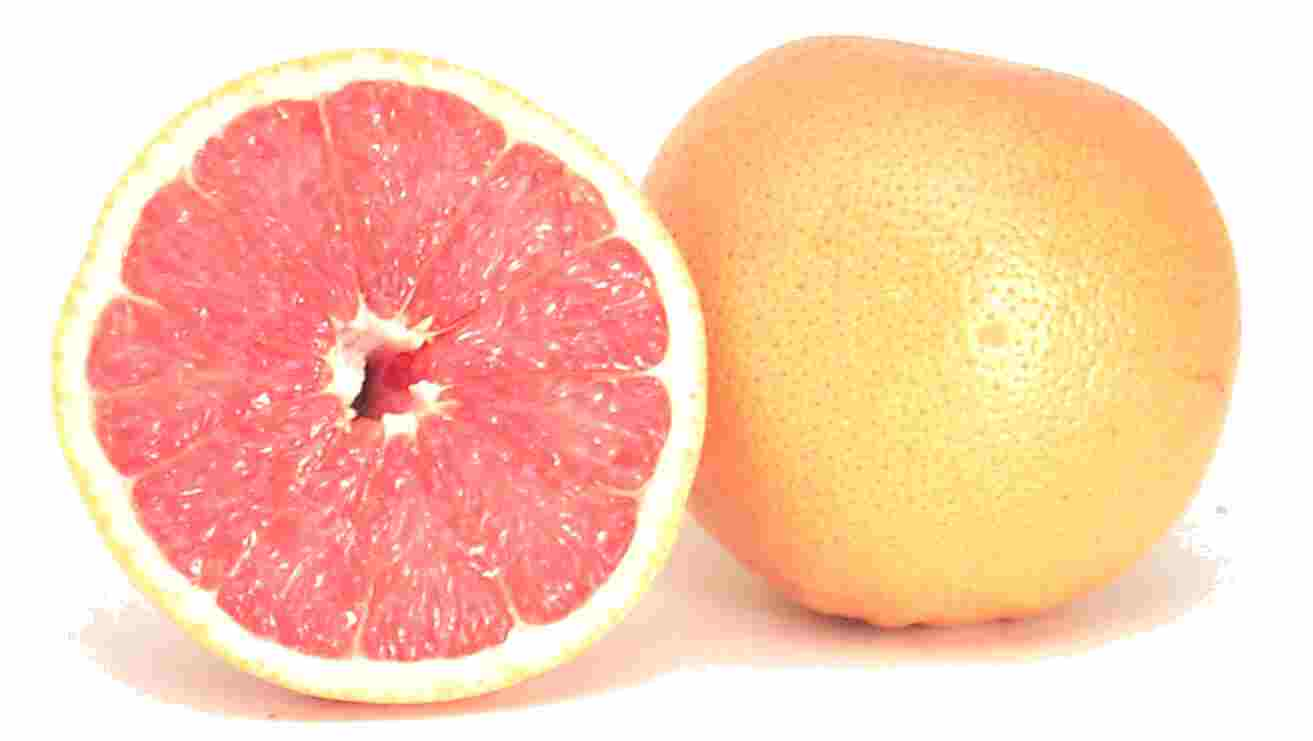
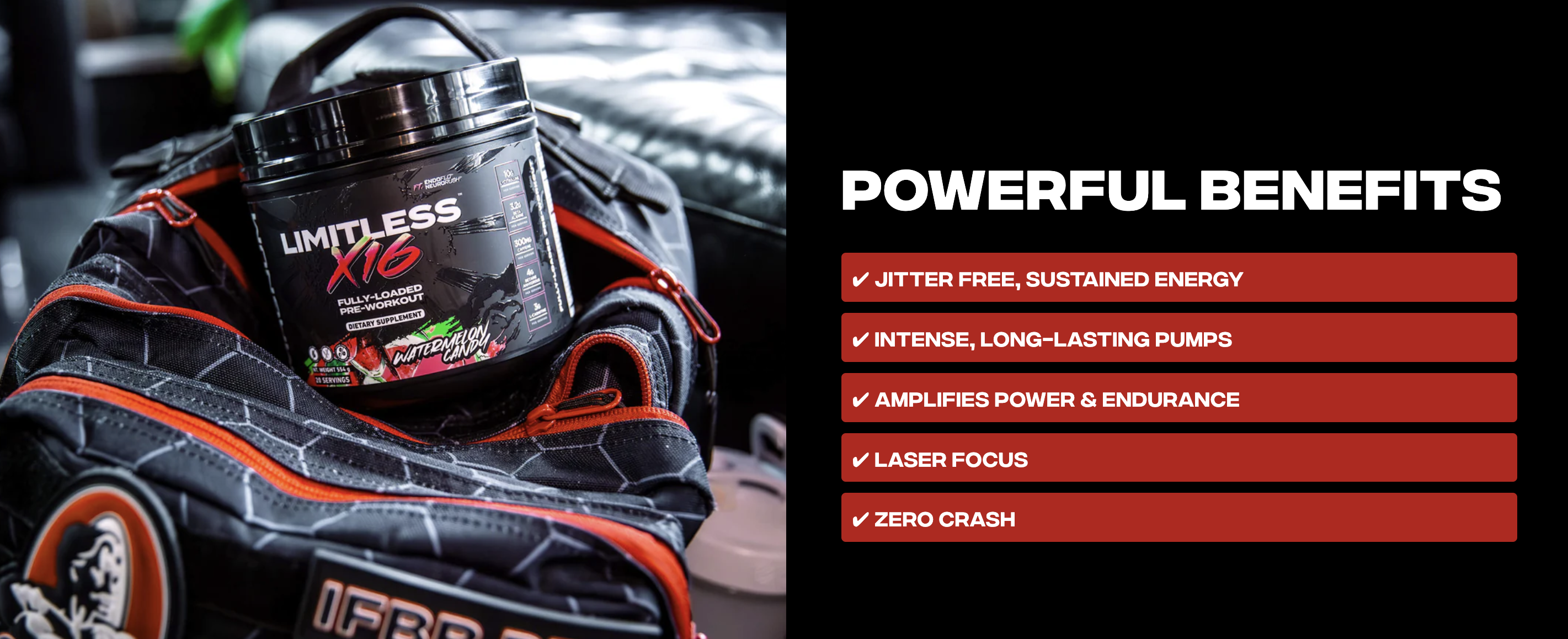


Comments and Discussion (Powered by the PricePlow Forum)